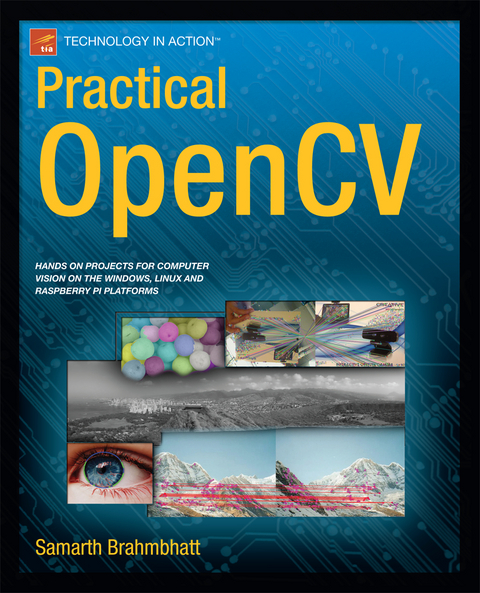Practical OpenCV
Seiten
2013
|
1st ed.
Apress (Verlag)
978-1-4302-6079-0 (ISBN)
Apress (Verlag)
978-1-4302-6079-0 (ISBN)
Practical OpenCV is a hands-on project book that shows you how to get the best results from OpenCV, the open-source computer vision library.
Computer vision is key to technologies like object recognition, shape detection, and depth estimation. OpenCV is an open-source library with over 2500 algorithms that you can use to do all of these, as well as track moving objects, extract 3D models, and overlay augmented reality. It's used by major companies like Google (in its autonomous car), Intel, and Sony; and it is the backbone of the Robot Operating System’s computer vision capability. In short, if you're working with computer vision at all, you need to know OpenCV.
With Practical OpenCV, you'll be able to:
Get OpenCV up and running on Windows or Linux.
Use OpenCV to control the camera board and run vision algorithms on Raspberry Pi.
Understand what goes on behind the scenes in computer vision applications like object detection, image stitching, filtering, stereo vision, and more.
Code complex computer vision projects for your class/hobby/robot/job, many of which can execute in real time on off-the-shelf processors.
Combine different modules that you develop to create your own interactive computer vision app.
Computer vision is key to technologies like object recognition, shape detection, and depth estimation. OpenCV is an open-source library with over 2500 algorithms that you can use to do all of these, as well as track moving objects, extract 3D models, and overlay augmented reality. It's used by major companies like Google (in its autonomous car), Intel, and Sony; and it is the backbone of the Robot Operating System’s computer vision capability. In short, if you're working with computer vision at all, you need to know OpenCV.
With Practical OpenCV, you'll be able to:
Get OpenCV up and running on Windows or Linux.
Use OpenCV to control the camera board and run vision algorithms on Raspberry Pi.
Understand what goes on behind the scenes in computer vision applications like object detection, image stitching, filtering, stereo vision, and more.
Code complex computer vision projects for your class/hobby/robot/job, many of which can execute in real time on off-the-shelf processors.
Combine different modules that you develop to create your own interactive computer vision app.
Part 1: Getting comfortable Chapter 1: Introduction to Computer Vision and OpenCV Chapter 2: Setting up OpenCV on your computer Chapter 3: CV Bling - OpenCV inbuilt demos Chapter 4: Basic operations on images and GUI windows Part 2: Advanced computer vision problems and coding them in OpenCV Chapter 5: Image filtering Chapter 6: Shapes in images Chapter 7: Image segmentation and histograms Chapter 8: Basic machine learning and keypoint-based object detection Chapter 9: Affine and Perspective transformations and their applications to image panoramas Chapter 10: 3D geometry and stereo vision Chapter 11: Embedded computer vision: Running OpenCV programs on the Raspberry Pi
| Zusatzinfo | 131 Illustrations, black and white; XII, 244 p. 131 illus. |
|---|---|
| Verlagsort | Berlin |
| Sprache | englisch |
| Maße | 178 x 254 mm |
| Themenwelt | Mathematik / Informatik ► Informatik ► Betriebssysteme / Server |
| Informatik ► Grafik / Design ► Digitale Bildverarbeitung | |
| Informatik ► Theorie / Studium ► Künstliche Intelligenz / Robotik | |
| ISBN-10 | 1-4302-6079-3 / 1430260793 |
| ISBN-13 | 978-1-4302-6079-0 / 9781430260790 |
| Zustand | Neuware |
| Haben Sie eine Frage zum Produkt? |
Mehr entdecken
aus dem Bereich
aus dem Bereich
alles zum Drucken, Scannen, Modellieren
Buch | Softcover (2024)
Markt + Technik Verlag
CHF 34,90
Modelle für 3D-Druck und CNC entwerfen
Buch | Softcover (2022)
dpunkt (Verlag)
CHF 48,85




